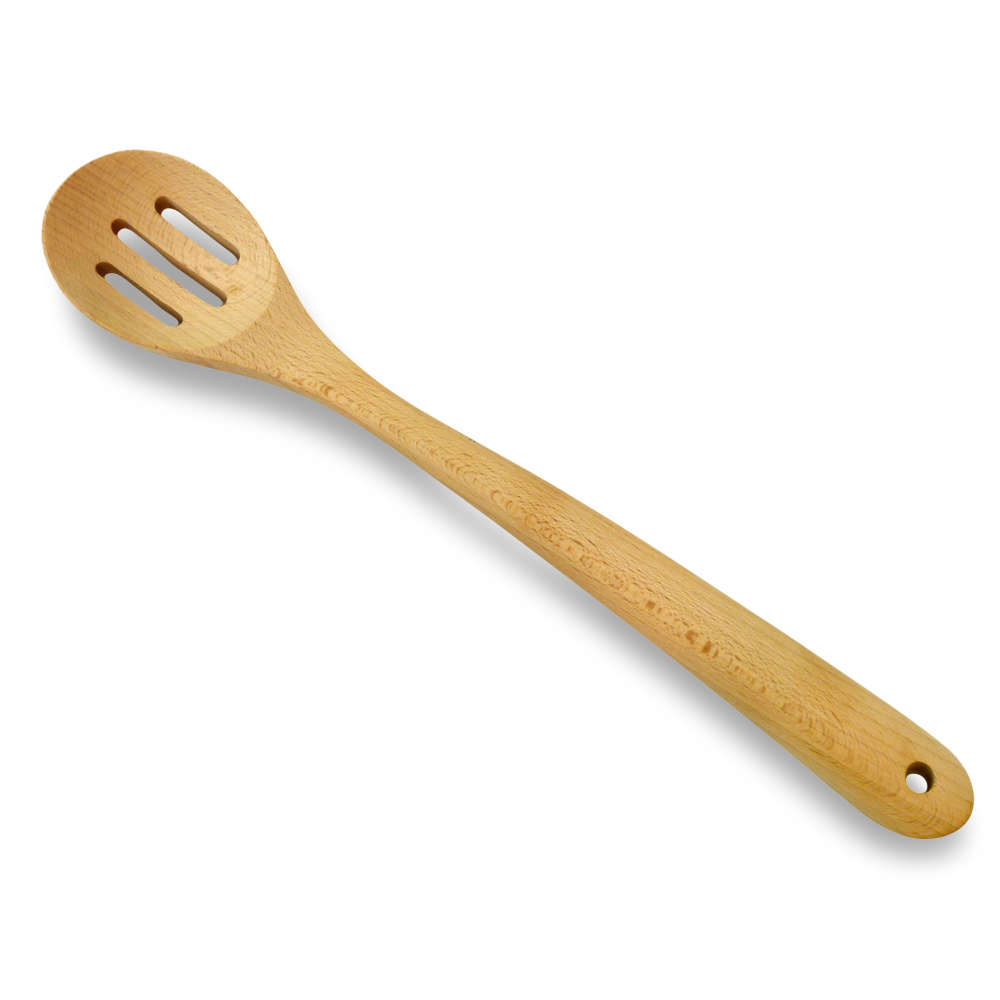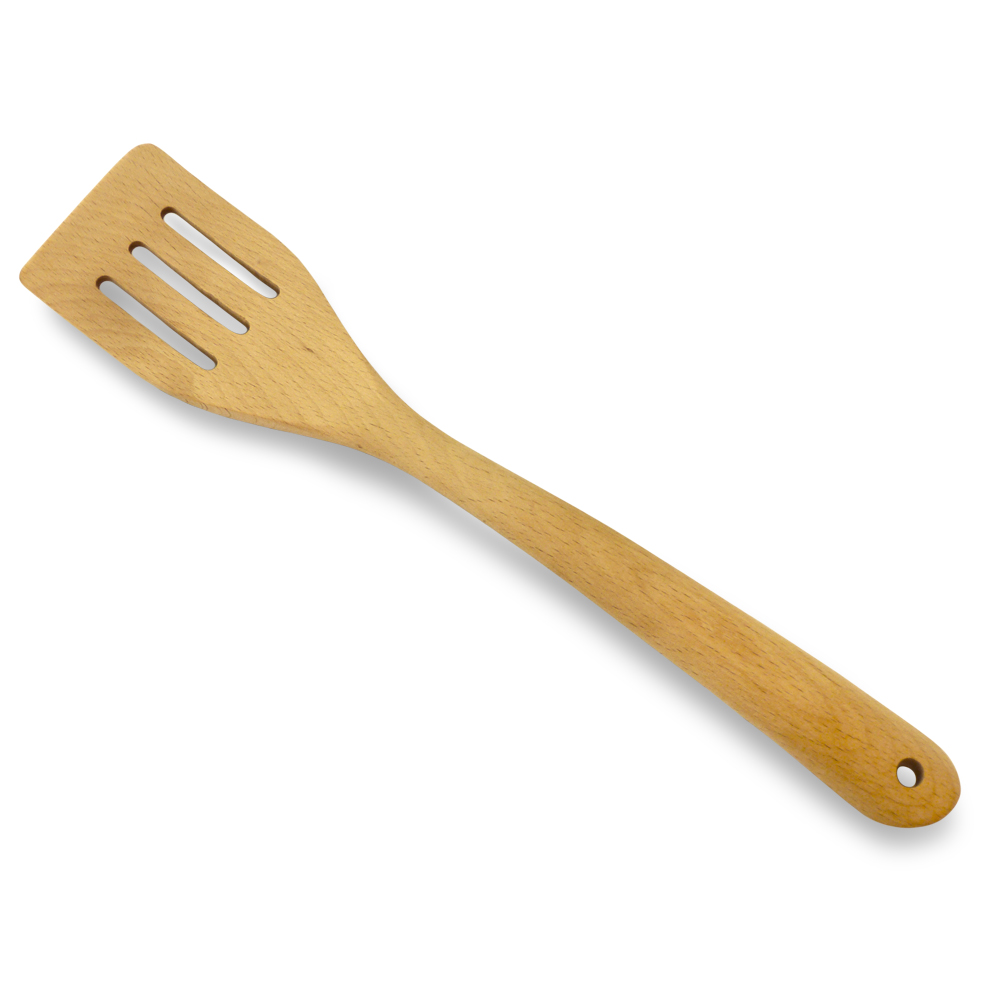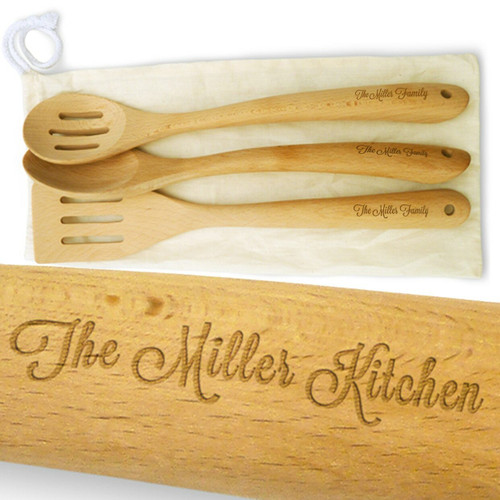
All About Wood Spoons
- Introduction
- History
- Choosing the right wood spoon
- Personalized wood spoons
- Wood spoon oiling/maintenance
- Wood spoon as an award
1. Introduction
They’ve been a staple in the kitchen for hundreds of years. In fact, wood spoons were one of the earliest recorded utensils ever to be used by human civilization. Not only were they simple to carve and highly practical, but making a wooden spoon was also extremely inexpensive thanks to the availability of materials. All you needed was soon wood and a means of shaping it.
These days, very few people are chopping logs and carving their own wood spoons, but they remain an essential tool in any person’s kitchen drawer. And, while modern tools like blenders and hand mixers may have taken over as our go-to device for certain jobs, there’s no way you could stir a soup or even mix a basic batter without the use of this handy utensil.
Up to this point, though, it’s very likely you never gave it a lot of thought. It’s something you pick up and use, then throw into the sink for a quick wash before it disappears back into your drawer without any acknowledgment of it's surprisingly interesting history. Here’s a look at where this little cooking device came from and the key aspects of choosing, caring for, and maintaining one today.
2. Where Did The Wooden Spoon Come From?
Did you know that the word “spoon” itself is actually derived from an ancient word that means chip of wood? Perhaps the earliest recorded use of the wood spoon is from 250BC when the Iron Age Celts of Britain used them for the same things we do today: cooking up a hearty meal.
This is actually evidenced by a small ladle that archaeologists discovered at the Glastonbury Lake Village. Later on, spoons were discovered from the Roman period in the City of London.
Looking back through history, the Anglo Saxons were known for being fantastic woodworkers, and so were the Vikings. Both groups were settlers of the British Isles and they used their talents to produce wooden spoons for familiar domestic uses that we still know today.
Although no longer hand-carved, the quality of materials that goes into a good wooden spoon today means your next set could very well outlast you in the kitchen. The trick is finding a place that uses high-quality woods and good workmanship, like the Cookbook People.
3. Choosing The Right Wooden Spoon
Maybe you’re a home chef that could rival the likes of Gordon Ramsey himself, or perhaps you just find yourself in the kitchen long enough to pop a meal in the microwave and run off to your next errand.
It doesn’t really matter where you fall on the spectrum because, if there is one thing everyone has at least one of tucked away into a drawer, it’s a wooden spoon. They come in every essential kitchen bundle you can buy, further cementing your need for one--or many.
The thing is, like most utensils, wooden spoons come in a lot of different sizes. They even come in varying shapes where the handle may be bent for easily resting on the edge of the pot or the spoon part itself may be wider, deeper, or even slatted to allow liquid to drain out while solids rest firmly inside the crater.
Of course, the most basic wooden spoon has a straight, not at all ergonomic handle with a reasonably sized, slightly concave end. It’s perfect for a quick stir or toss, never calling attention to itself.
After much testing and time in the kitchen, most would agree that the 14” length is ideal for a wooden spoon. It’s long enough for the handle to sit safely outside of a pot or pan without being so long that it’s cumbersome to use or store.
It’s also generally agreed that you need three main types of wood spoons to do most work in the kitchen. Here’s a look:
- The basic wooden spoon. The staple of any kitchen craft. The basic wooden spoon can stir anything you need mixed, be it a batter, soup, or stir-fry. You could even grab two and toss a salad together in no time flat! The versatility of the basic wooden spoon is a marvel of simplicity. You really shouldn’t be at home without it.

- The slatted wooden spoon. Ideal for stews and even pasts, the slatted wooden spoon allow liquid to drain through while enabling you to pick up meats, veggies, or other larger ingredients with ease to achieve perfect balance in any serving.

- The wooden spatula. While some may argue it’s hardly a spoon at all, no wood spoon set would truly be complete without a wooden spatula. This isn’t a spatula you’d use to flip burgers. Rather, it’s made for tossing ingredients as you fry them or mixing certain dishes (similarly to a spoon).

Of the three, we find that pretty consistently for every 5 solid wood spoons we sell, we'll sell 1.5 slotted wood spoons and 1 wood spatula. If you have to pick one to offer as a gift, the solid spoon is your best option.
Luckily for you, finding a set with all three of these essentials isn’t tough at all, so long as you know where to look. When buying, make sure that you read reviews that can attest to the quality of materials and workmanship of the product.
While no longer carved by hand, you’ll still want to triple-check that wherever you’re buying your wooden spoons from are putting enough thought and care into the production of them. Otherwise, you will end up with a spoon that’s flimsy, brittle, or otherwise cheap and likely to break (or splinter) in just a matter of a few uses.
If you take care of a good wooden spoon set, they could even outlast you in the kitchen, so don’t hesitate to spend a few extra bucks for a good bundle--especially if you can get it personalized!
4. Personalized Wooden Spoons
Perhaps you love cooking or you just like looking like you do. In any case, a personalized wooden spoon set is just about all it takes to turn guests’ heads.
With something so simple as a wooden spoon, just a little bit of personalization goes a long way in helping pull together your kitchen space. They are fantastic for display or can be humbly kept in a jar by the stove or even tucked into a drawer.
No matter where you keep them, when you bring them out for use, you’ll garner the extra respect your cooking skills deserve! Personalized wooden spoons are actually a favorite to give and receive as a housewarming present or as a thoughtful gift for the inspiring chef or baker.
If you choose a personalized wood spoon and spatula set from Cookbook People, you’ll be getting three high-quality wood spoons that will last you a lifetime in the kitchen. Each is 14” long, one being the standard basic wooden spoon, the second being a wooden spatula, and the third being a slotted spoon--absolutely everything you need to get going in the kitchen!
On the handle, you can put your favorite quote or your family name to add that extra bit of special to every dish you whip up. They make a great gift that the recipient is sure to adore. Once you order, the only thing left to do is to brush up on the basic maintenance and care tips so that your wooden spoons will continue looking like new.
Here's a video one of our customers made of her set:
You can find these spoons on our site here. Or click this image:
They're a 5 star product with more than 50 reviews, so people seem to like them!
You can certainly find other samples of wood spoons online that are perhaps less functional but feature a more prominent image on the bowl of the spoon:
These are pretty striking, but do be aware that they tend to be more budget solutions and more ornamental in nature. Cleaning the grooves of the engraving after cooking with them may be a little tricky!
5. Wood Spoons: Oiling, Proper Care and Maintenance
At first thought, you might find it absolutely silly that there would be a maintenance guide for something so unassuming as a wooden spoon. It’s a piece of wood, after all--what is there to maintain? Well, if you have a wood cutting board, you should know that proper maintenance goes beyond a simple wash.
In reality, it’s important that you properly care for any piece of wood or other porous surface in your kitchen. Not so much because of how it looks or even how long it will last, but simply for food safety. Wood is a fantastic, durable, and natural material that we use for so many things, but even still, it requires just a couple of extra steps to make sure you’re doing everything right.
In the event of a wooden spoon, maintaining it is a simple, quick process so long as you consistently follow this straightforward process.
A. Clean After Each Use
You should never allow a wood spoon to sit with food particles (and especially liquids) on it after you are done using it. This isn’t a piece that you should throw into the dishwasher or let sit in the sink for hours on end, either. You should promptly clean any wood spoon you use as soon as you’re done with it.
If you have more than one spoon to clean, you can save time (and water) by filling a bowl up with warm water and sitting them all into the bowl. Use just a teaspoon of soap in the bowl and a wet nylon scrubbing pad to remove any food particles from the spoons.
When done cleaning, always rinse your wood spoons off well using warm, clean water. Dry them with a non-fraying towel as much as you can by hand, and then hang them on a utensil hook so that they can finish drying before you throw them back into the dark drawer. Putting them away wet could lead to the development of bacteria.
B. Sanitize Regularly
Regular sanitization is essential, especially if you use your wooden spoons to toss or stir products that are at a particularly high risk of harbouring bacteria. This would include things like raw or undercooked meat (like in stir-frys) or dairy and egg products (like in batters).
When you throw utensils into the dishwasher, they are generally sanitized for you because the warm/hot water combined with the hot, quick drying process means all germs and bacteria are killed before anyone even opens the dishwasher door.
With things that must be hand washed, though, like your wood spoons, you will want to complete your own sanitization process every so often. How often that is really depends on how often you use your spoons. If you use them regularly (i.e., once a week or more), you should probably sanitize them every 6-8 weeks for good measure. More often if they regularly come in direct contact with meat or other high-risk ingredients mentioned before.
The sanitization process itself is no fuss at all. Simply clean the spoons as you normally would and then lay them out onto a clean, flat surface. A baking sheet works great for this, but make sure it has a slight lip. The next step is to pour 3% hydrogen peroxide over the spoons. This kills any bacteria that may be on the spoons.
Give the peroxide about 15 minutes to kill the bacteria and then rinse the spoons off in warm water. Be certain that you hang the spoons up to dry properly before putting them away.
C. Oil As You Please
We've put together a little video showing how different oils look after applying to wood spoons:
Many people couldn’t care less about what their wood spoons or other cooking utensils looked like. But, if you have a particularly special spoon--like an engraved one--or you just like to keep your kitchen tools in magazine-perfect shape, you might want to oil your wood spoons.
Oiling your wood spoons is simple and it goes a long way in keeping them in like-new condition. It not only makes them look better, but it also prevents the wood from drying out over time, which can eventually lead to splintering.
Just select a food-grade mineral oil and rub it onto the spoons. This oil will definitely prolong the life of your spoons and you’ll instantly see older spoons revitalized as soon as you oil them up.
After applying the oil, there is no need to rinse. Instead, just hang the spoons up to dry. To allow the oil to fully sink in and do its job, penetrating beyond the surface, you should not use the spoons until the oil has dried completely.
6. Wood Spoon Award
Although pretty much unheard of in the USA, in Britain and many other commonwealth countries it is common to award a wood spoon for last place. It started at Cambridge more than a hundred years ago, and continues on for sports prized and perhaps most famously now in many British pub quizzes as a last place gift. I've "won" a few of them myself, sadly. :)
Conclusion
With all of that, you probably know more than you ever thought you would about this handy kitchen utensil. Now how about picking up a personalized wooden spoon of your own? Check out our customizable set here.



